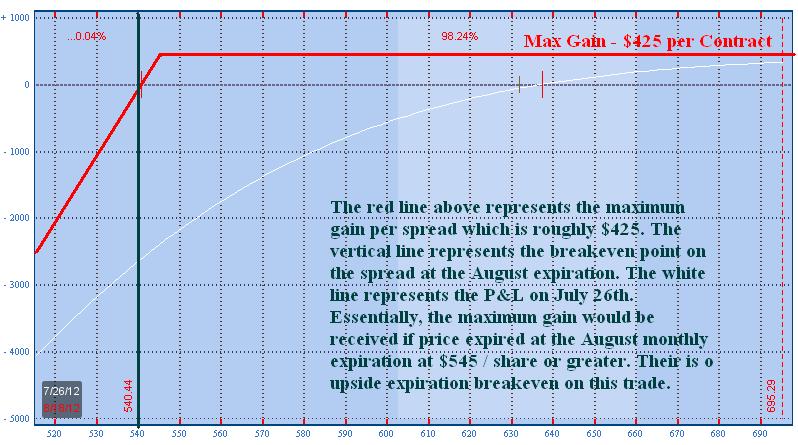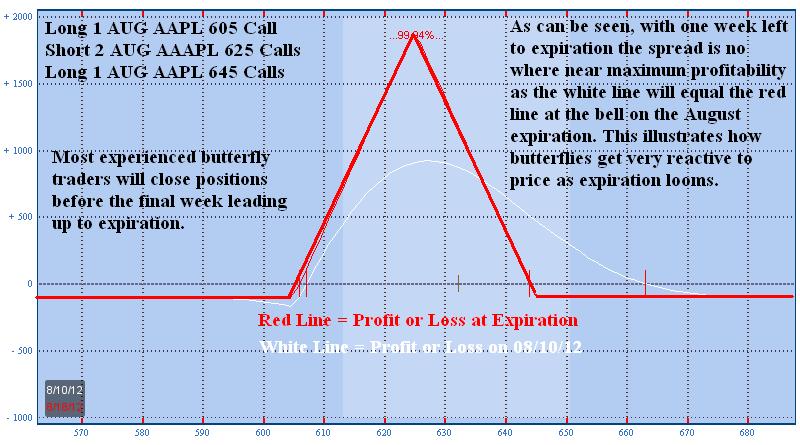Apple Stock Trading Considerations for Options Expiration Week
Companies / Tech Stocks Aug 15, 2012 - 09:29 AM GMTBy: J_W_Jones
 “The girls all get prettier at closing time.” ~ Mickey Gilley ~
“The girls all get prettier at closing time.” ~ Mickey Gilley ~
Option trading is not “just the same as stocks.” It turns on the three primal forces ruling an options trader’s world- time to expiration, price of the underlying, and implied volatility.
As expiration approaches, the forces of time exert their strongest influence of the cycle on a trader’s positions. In today’s blog, written as August expiration is but a few days away, I want to call attention to some of the practical considerations traders would be well advised to incorporate into their trading plan.
Pundits have long cited the aphorism that there are only two sure things in life- death and taxes. Options traders must incorporate a third inevitability- the time component (aka the extrinsic component) of an option premium goes to zero at the closing bell of options expiration. This occurrence is neither negotiable nor avoidable and it occurs with clockwork like precision.
A recent change to the market has introduced an important new element to the long standing monthly expiration cycle. The tremendous popularity of weekly options has rendered every Friday the end of an expiration cycle.
It is critically important to recognize this new phenomenon because it allows tailoring of strategies to fit more precisely the anticipated time frame in which the trader’s hypotheses play out.
Let us consider some of the practical implications of this cyclical pattern. I have discussed before in this blog the fact that erosion of time premium is not linear across the life of an option but accelerates dramatically as expiration approaches. Expiration week is where this acceleration reaches its greatest pace as it heads to zero at Friday’s closing bell.
What is often not immediately understood by the new option trader is the radical change in the risk / reward ratio of a trade produced by this erosion. Consider a simple one legged trade. A trader who was bullish on AAPL during the price weakness in late July could have chosen to sell naked puts to reflect his price view. The graph below shows the trade of selling short the August 545 strike put at mid day on Thursday July 26 with 23 days to expiration:

AAPL Option Trading
The trader would have taken a credit of around $425 for each contract he sold on this trade with a probability of success of 84%. The trade could have been closed last Friday for $16/contract locking in $409 per contract less commission.
While the probability of AAPL trading below the 545 strike as August expiration approaches is close to 0, it is not O. To accept the risk of a Black Swan event occurring in order to capture the remaining 3.8% of the initial credit is not smart trading. The general rule-of-thumb I follow in this type of trade is to close or roll up the position to a higher strike when 80% of the initial credit received has been captured.
Perhaps the most nuanced effect of time to expiration is seen in the behavior of the butterfly trade construction. To review briefly, remember that the classic butterfly is constructed in either calls or puts and consists of both a debit and a credit spread which share the same short strike.
Butterfly positions have the interesting characteristics of responding only minimally if at all to price movement when far out in time from expiration. These same trade structures will react violently to price movement when little time to expiration remains.
An example could be constructed during the July AAPL price rout. Let us assume a trader was sufficiently prescient to predict the price recovery. In order to capture this hypothesized movement, he could have purchased the August 605/-625/645 in a (×2/+1 standard butterfly ratio) call butterfly spread on July 26th. This trade structure is a defined risk position where the maximum risk is the cost of entering the position.
This position would have been very inexpensive because of two factors:
1. Implied volatility was elevated, rendering the butterfly cheap.
2. The center strike where the options were sold short and the point of the theoretical maximum profitability had less than a 5% chance of being in-the-money.
The P&L graph for this position at the time of entry is presented below:

AAPL – Apple Option Trading
Several practical points bear emphasis. First, the maximum potential profit from this low probability trade is in excess of 1800%. This trade construction which cost around $100 per spread at the time could have been closed last Friday for a profit of over $850 per spread.
Second and the point germane to today’s discussion is the behavior of the trade with regard to time. Notice that the broken lines, representing intermediate time points in the trade achieve nowhere near the full profit potential that exists when expiration arrives.
However, not to be missed is the fact that the range of profitability narrows dramatically as expiration is approached. It is for this reason that most experienced butterfly traders remove profitable trades before their wild relationship to price is activated as expiration gets quite close.
I want to be very clear about this demonstrated butterfly trade. This is not a typical trade I would enter because of its low probability of success. I present it as a purely educational exercise to demonstrate the behavior of these frequently encountered trade structures.
I invite you to try my service to follow my trades and understand how the nuanced behavior of options can be used to deliver highly profitable trades.
Happy Option Trading!
 If you are looking for a simple one trade per week trading style then be sure to join www.OptionsTradingSignals.com today with our 14 Day Trial.
If you are looking for a simple one trade per week trading style then be sure to join www.OptionsTradingSignals.com today with our 14 Day Trial.
J.W. Jones is an independent options trader using multiple forms of analysis to guide his option trading strategies. Jones has an extensive background in portfolio analysis and analytics as well as risk analysis. J.W. strives to reach traders that are missing opportunities trading options and commits to writing content which is not only educational, but entertaining as well. Regular readers will develop the knowledge and skills to trade options competently over time. Jones focuses on writing spreads in situations where risk is clearly defined and high potential returns can be realized.
This article is intended solely for information purposes. The opinions are those of the author only. Please conduct further research and consult your financial advisor before making any investment/trading decision. No responsibility can be accepted for losses that may result as a consequence of trading on the basis of this analysis.
© 2005-2022 http://www.MarketOracle.co.uk - The Market Oracle is a FREE Daily Financial Markets Analysis & Forecasting online publication.



